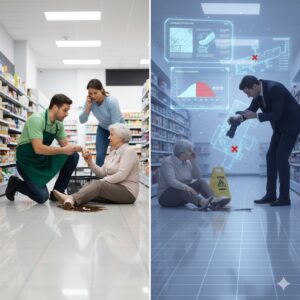What To Check First If Someone Slips in Your Home or Business
Slips happen fast — one second everything is normal, and the next there’s a thud, a startled shout, and a moment of panic as you rush over to help. Whether it happens at home, in a shop, or at a workplace, those first few moments can feel chaotic. That’s often when people begin wondering whether they should look into floor slip testing or other safety measures to understand what went wrong and how to prevent it from happening again.
Even a minor slip can create anxiety for both the person who fell and the person responsible for the space. But panic doesn’t help anyone. What matters most is knowing exactly what to check right away to protect the injured person, gather accurate information, and understand whether there’s a hidden safety risk that needs attention.
1. Check the Person First — Not the Floor
It’s natural to want to inspect the surface straight away, but your priority should always be the individual who slipped.
Make sure they’re safe and conscious
Ask simple questions like:
- “Are you okay?”
- “Do you feel pain anywhere?”
- “Can you move comfortably?”
Avoid moving them if they’re in pain
If someone hits their head, back, or hips, moving them could worsen the injury.
Call for medical help if needed
If they’re dizzy, confused, unable to stand, or in severe pain, it’s safer to get professional assistance.
Once you’re sure they’re stable, then you can shift your attention to what caused the fall.
2. Identify the Immediate Cause of the Slip
Slip hazards aren’t always obvious. Sometimes it’s a spill, but other times it’s something less noticeable, like a subtle change in flooring texture or a small patch of residue.
Check for:
- Water, oil, or liquid spills
- Unexpected moisture near entrances
- Loose rugs or mats
- Worn or uneven flooring
- Powdery substances like dust or dirt
- Leaking appliances, pipes, or equipment
Take photos while the area still looks exactly as it did during the incident. This provides clarity later, especially if the cause isn’t immediately obvious.
3. Look at Footwear and Conditions
Sometimes the environment plays a role in a slip — not just the floor itself.
Consider:
- Was the person wearing shoes with worn-out soles?
- Was it raining outside, causing wet shoes to track moisture indoors?
- Was the lighting dim, making it harder to see hazards?
- Was the person carrying something heavy or bulky?
This isn’t about assigning blame — it’s about understanding all the factors so you can address them effectively.
4. Check the Surrounding Area for Contributing Factors
Slips often happen because multiple elements come together at once. Even if you’ve found an obvious cause, it’s worth taking a quick look at the broader area.
Look for:
- Narrow walkways
- Clutter or objects on the ground
- Recently cleaned floors that might still be damp
- Flooring transitions (e.g., carpet to tiles)
- Improperly placed signage
These details help you understand whether the environment as a whole contributed to the fall.
5. Determine Whether the Surface Is Too Slippery
Some surfaces are naturally more hazardous than others, especially when wet. You may notice:
- The flooring feels smooth or glossy
- Shoes slide easily across it
- Moisture spreads rather than absorbing
- The slip happened even without a visible spill
These are signs the floor might not have enough traction. This is where professional testing becomes helpful, as it measures how slippery the surface is and whether it meets safety standards.
6. Record the Incident Calmly and Accurately
Accurate information helps prevent future accidents and protects everyone involved.
Document:
- What time the slip occurred
- What the person was doing
- What the floor conditions were
- Weather conditions (if relevant)
- Who witnessed the fall
- Photos of the area
If you’re a business owner, incident reporting isn’t just smart — it’s often required.
7. Take Preventive Steps Immediately After
Prevention is always easier and more affordable than dealing with ongoing risk.
Consider:
- Placing signs near known problem areas
- Cleaning spills promptly
- Using mats near entrances
- Improving lighting in dim areas
- Reviewing cleaning products that may leave slippery residue
- Rearranging furniture or displays to improve movement flow
Small adjustments can dramatically reduce future incidents.
Being Prepared Protects Everyone
A slip can be stressful, but knowing what to check first helps you stay calm and take meaningful action. When you prioritise the person’s safety, understand the cause of the incident, and document everything clearly, you’re better prepared to make your space safer in the future.
Slips will always happen from time to time — but how you respond can make all the difference.


